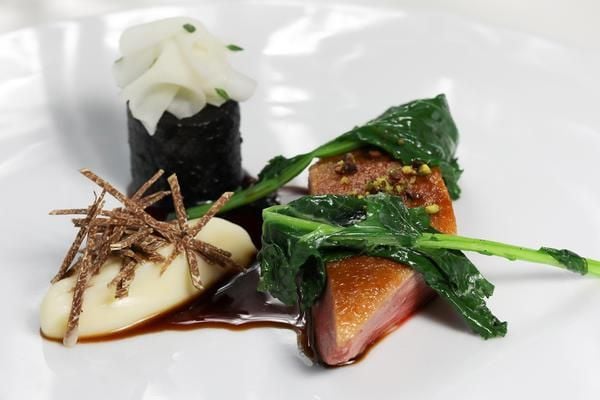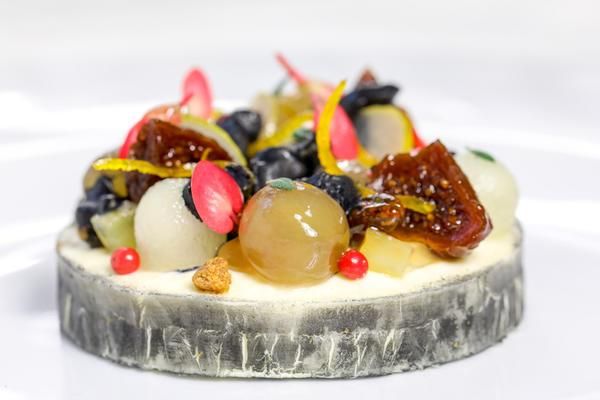Dine Like a Doomed Pompeiian at This Upscale Eatery
Starting early next year, Dinner by Heston in London will serve a menu inspired by ancient Roman fare
:focal(577x342:578x343)/https://tf-cmsv2-smithsonianmag-media.s3.amazonaws.com/filer/d5/af/d5af259d-31ee-44eb-8284-2128ec97c5f2/el7d2v0xuay0jie.jpg)
The team behind Dinner by Heston has a taste for the macabre.
Starting early next year, the upscale London eatery will be rolling out a series of morbid menus featuring the probable “last suppers” of the doomed denizens of Pompeii, the voyagers aboard the pre-iceberg Titanic and Napoleon Bonaparte on the eve of his death, reports Meara Sharma for the New York Times.
Intended to plunge diners into the realm of “narrative fantasy,” the offerings will be largely historically inspired (with some modern updates vis-à-vis hygienic food preparation and gastronomical flair), head chef Heston Blumenthal tells Sharma.
First up is a tribute to Roman cuisine, inspired by an ongoing exhibition at the Ashmolean Museum at the University of Oxford titled “Last Supper in Pompeii.” As Meilan Solly reported for Smithsonian magazine earlier this year, the show immortalizes the hearty, eclectic Roman appetite through more than 300 artifacts, including frescoes, dinnerware and carbonized baked goods more than a millennium in the making. All hail from the archaeological site of the 79 A.D. volcanic eruption that blanketed the ancient city of Pompeii in scorching ash, freezing its inhabitants—and their belongings—for the world to dig up many centuries later.

Of course, the majority of the Pompeiians’ actual fare was lost in the catastrophe. But some foodstuffs made it through relatively intact, if not egregiously overcooked. Among them are olives, eggs, figs, almonds, lentils, and even a loaf of bread, sliced and ready to eat.
Curators then filled in some of the gaps with other artifacts, including a jar that probably once housed a live dormouse, steadily fattened with acorns and chestnuts for humans’ future consumption, Mark Brown reported for the Guardian earlier this year. These petite rodents were once considered a delicacy—especially when stuffed with pork mince, seasoned and baked, as the Romans often did (and as the Croatians and Slovenians still do today).
For better or worse, no dormice made it onto the Blumenthal’s Pompeiian menu. But as Sharma reports, that particular dish is unlikely to be missed amongst the feast he and executive chef Ashley Palmer-Watts do lay out. The meal begins with blackened bread—drawing directly on the exhibition’s carbonized loaf—and a side of squid ink-infused butter. Pickled mussels and roasted duck follow, before the meal is capped off with libum, a dessert of baked cheese curds.

To craft the menu, Blumenthal drew from both the Ashmolean exhibition and a first-century Roman cookbook known as Apicius. But as Sharma reports, the chef considers these recipes of the past “a jumping-off point” rather than a strict set of instructions.
Dining on a dinner reminiscent of the dead might seem unsavory to some. But Blumenthal intends his food to be transportive—an homage, not a mockery. As Xa Sturgis, Director of the Ashmolean, said in a statement earlier this year, “In the food-obsessed culture of today, there is scarcely a better topic that can help us make a connection with the people of the ancient world.”
That link becomes clearer when considering the fact that the ancient Pompeiians likely had death on the brain, too, perhaps in the best way possible. The grind of daily Roman life was punctuated by frequent and purposeful reminders of mortality: Symbols of skeletons adorned feasting cups and dining room walls. The juxtaposition of death with one of life’s greatest pleasures—feasting alongside loved ones—served to heighten the joys of existence, at least while it lasted.
One exhibit in “Last Supper in Pompeii” pays tribute to this idea: a floor mosaic depicting a full-length human skeleton, toting a wine jug in each hand, Farah Nayeri reported for the New York Times earlier this year.
“The two worlds of death and the banquet, the table and the grave, were never far apart,” reads the exhibition’s wall text. “The message is very clear: Carpe diem—seize the day. Enjoy the delights of the banquet while you can.”
The Ashmolean is holding a competition to win “The Last Supper in Pompeii” meal, including paired wines, for four people at Dinner by Heston. The competition concludes on January 31, 2020. The menu will be available from January 7 to March 31.
/https://tf-cmsv2-smithsonianmag-media.s3.amazonaws.com/accounts/headshot/10172852_10152012979290896_320129237_n.jpg)
/https://tf-cmsv2-smithsonianmag-media.s3.amazonaws.com/accounts/headshot/10172852_10152012979290896_320129237_n.jpg)